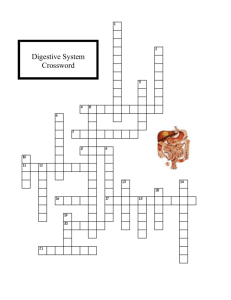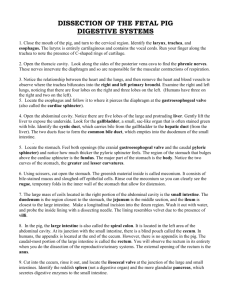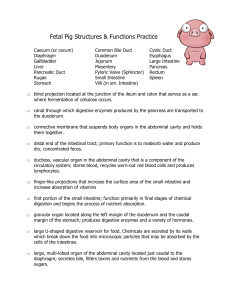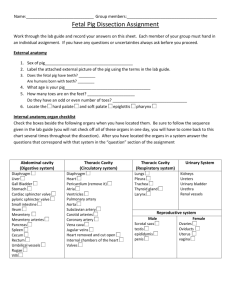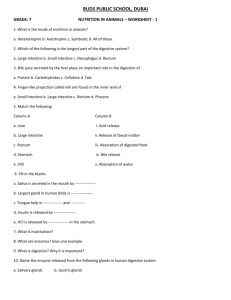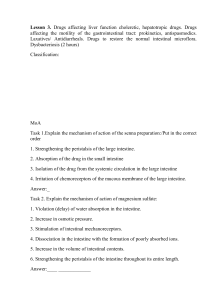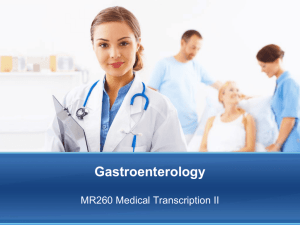MS I Digestive Study Guide
advertisement
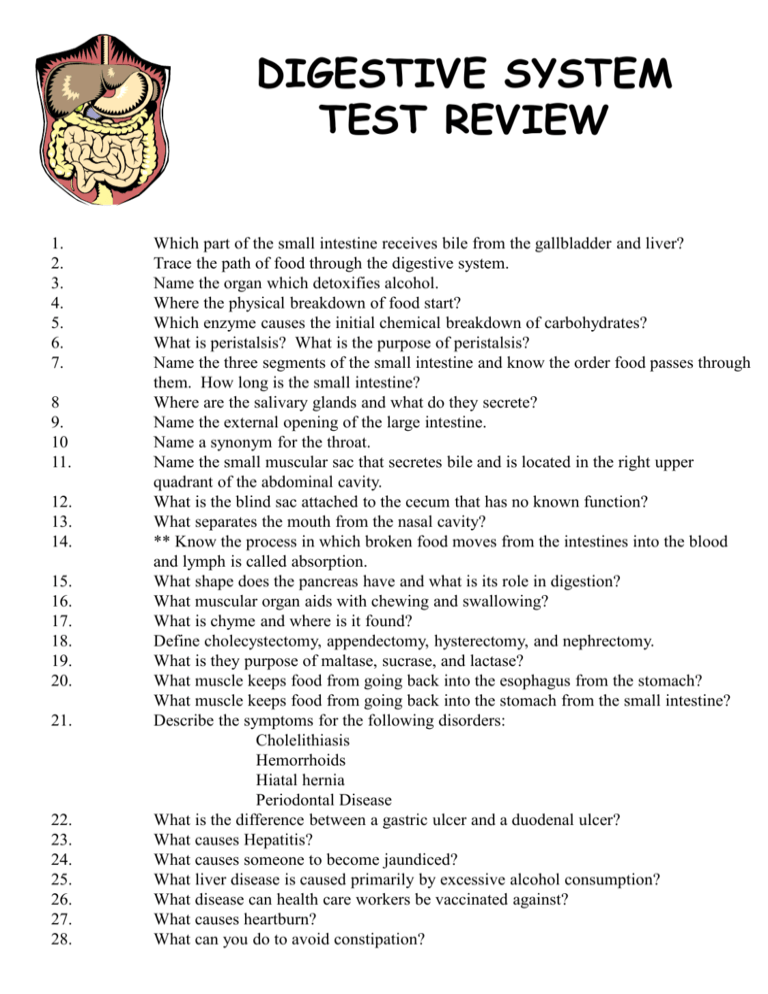
DIGESTIVE SYSTEM TEST REVIEW 1. 2. 3. 4. 5. 6. 7. 8 9. 10 11. 12. 13. 14. 15. 16. 17. 18. 19. 20. 21. 22. 23. 24. 25. 26. 27. 28. Which part of the small intestine receives bile from the gallbladder and liver? Trace the path of food through the digestive system. Name the organ which detoxifies alcohol. Where the physical breakdown of food start? Which enzyme causes the initial chemical breakdown of carbohydrates? What is peristalsis? What is the purpose of peristalsis? Name the three segments of the small intestine and know the order food passes through them. How long is the small intestine? Where are the salivary glands and what do they secrete? Name the external opening of the large intestine. Name a synonym for the throat. Name the small muscular sac that secretes bile and is located in the right upper quadrant of the abdominal cavity. What is the blind sac attached to the cecum that has no known function? What separates the mouth from the nasal cavity? ** Know the process in which broken food moves from the intestines into the blood and lymph is called absorption. What shape does the pancreas have and what is its role in digestion? What muscular organ aids with chewing and swallowing? What is chyme and where is it found? Define cholecystectomy, appendectomy, hysterectomy, and nephrectomy. What is they purpose of maltase, sucrase, and lactase? What muscle keeps food from going back into the esophagus from the stomach? What muscle keeps food from going back into the stomach from the small intestine? Describe the symptoms for the following disorders: Cholelithiasis Hemorrhoids Hiatal hernia Periodontal Disease What is the difference between a gastric ulcer and a duodenal ulcer? What causes Hepatitis? What causes someone to become jaundiced? What liver disease is caused primarily by excessive alcohol consumption? What disease can health care workers be vaccinated against? What causes heartburn? What can you do to avoid constipation? 29. 30. 31. 32. 33. 34. 35. 36. 37. 38. 39. 40. 41. 42. 43. 44. 45. 46 47. 48. 49. 50. 51. 52. 53. 54. 55. 56. 57. List the different types of leukocytes. What is the liquid part of blood called? What is hemoglobin composed of? What is the medical term for platelets? ** Two important electrolytes found in blood plasma are sodium chloride and potassium. What medical condition do you have when you have a low number of red blood cells? How many quarts of blood does the average adult have? What is the main function of erythrocytes? What blood type is the universal recipient? Universal donor? What is hereditary disease where the blood clots slowly or abnormally? What is leukopenia? What is Phagocytosis? ** Know that the condition that exits when oxygen is crowded out of the hemoglobin and can be fatal is carbon monoxide poisoning. ** What are fibrinogen and prothombin necessary for? What is the main function of leukocytes? Why is arterial blood bright red? **Remember blood type is determined by the presence or absence of a blood protein called an antigen. ** List all the facts in your book about prothombin. What would happen if an Rh negative person were given a transfusion of RH positive blood? Define diapedesis. Why is research being done on the use of newborn umbilical cord blood? ** Know that an abcess is a pus-filled cavity that forms when there is infection below the epidermis. ** Define anemia. Who would get Rho Gam? What is Erythoblastosis fetalis and who get it? What blood disease is inherited from both parents? ( hint: seen mainly in African Americans.) What is pyrexia? What are the plasma proteins? Describe how a red blood cell is shaped.

